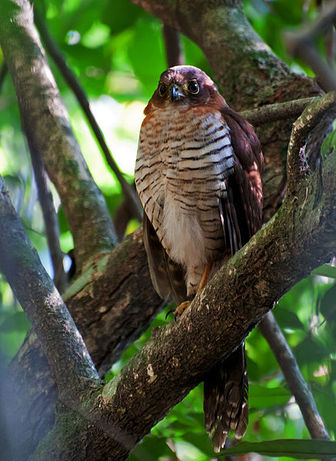Barred Forest Falcon
Adults of most subspecies are typically dark slate grey above; the tail tipped with white and having three to six narrow white bars. The nominate subspecies, which is found from south-eastern Brazil south to north-eastern Argentina and west to Paraguay, appears to only occur in the rufous-brown morphotype, as also suggested by its scientific name, ruficollis.

Original source: Dario SanchesPermission(Reusing this file)This image, which was originally posted to Flickr.com, was uploaded to Commons using Flickr upload bot on 15:24, 10 August 2011 (UTC) by Snowmanradio (talk). On that date it was licensed under the license below. This file is licensed under the Creative Commons Attribution-Share Alike 2.0 Generic license.You are free:to share – to copy, distribute and transmit the work
Author: Dario SanchesPermission(Reusing this file)This image, which was originally posted to Flickr.com, was uploaded to Commons using Flickr upload bot on 15:24, 10 August 2011 (UTC) by Snowmanradio (talk). On that date it was licensed under the license below. This file is licensed under the Creative Commons Attribution-Share Alike 2.0 Generic license.You are free:to share – to copy, distribute and transmit the work
The Barred Forest Falcon is classified as Least Concern. Does not qualify for a more at risk category. Widespread and abundant taxa are included in this category.
In Acre, Brazil, the Barred Forest Falcon is reported to prefer "disturbed forest types, both natural secondary and man made, including bamboo and more open seasonally drier forest on rocky outcrops. The adult male is dark slate grey above; his tail tipped with white and having three narrow white bars. The throat is pale grey, shading to the darker slate of the crown. The rest of his under parts, including the under-wing coverts are white, finely and clearly barred with black. More
* Barred Forest Falcon, Micrastur ruficollis * Plumbeous Forest Falcon, Micrastur plumbeus * Lined Forest Falcon, Micrastur gilvicollis * Cryptic Forest Falcon, Micrastur mintoni * Slaty-backed Forest Falcon, Micrastur mirandollei * Collared Forest Falcon, Micrastur semitorquatus * Buckley's Forest Falcon, Micrastur buckleyi Copyright: Wikipedia. More
Alternate common name(s): Barred Forest Falcon, Barred Forest-falcon Old scientific name(s): None known by website authors Photographs Huitepec Ecological Reserve, Chiapas, Mexico - Apr, 2003 More
Family : Falconidae
Genus : Micrastur
Species : ruficollis
Authority : (Vieillot, 1817)

